
Gokul B. Naidu – November 1, 2024
Collected at: https://www.iotforall.com/a-b-vs-traditional-over-the-air-firmware-updates
In the increasingly digital landscape of the Internet of Things (IoT), the ability to deliver firmware updates securely and reliably is paramount. Over-the-air (OTA) A/B firmware updates have transformed how device manufacturers and developers distribute software updates, playing a crucial role in rolling out new features and addressing security vulnerabilities without the need for costly device recalls.
Typically, there are two types of OTA update methods: (a) Single Partition and (b) Dual Partition. The latter is often referred to as A/B OTA or seamless OTA.
Single Partition OTA
Single partition OTA involves directly updating the firmware to replace the existing version. This process occurs in a sequence of steps, which includes applying the update and rebooting the device. This can result in significant downtime or limited functional availability during the update installation process. If the update fails due to reasons such as a power outage or battery failure, recovering the device can become complicated, potentially rendering it inoperable. Often, failed OTA updates require manual reprogramming, making recovery cumbersome and time-consuming.
While this method has been widely used in the industry for many years and offers simplicity in implementation, it carries known limitations that can negatively impact the user experience. The ease of management and lower storage requirements since only one partition is used can provide a cost-benefit. However, these advantages come at the risk of downtime and the possibility of bricking devices during failed updates.
The security aspect of single-partition OTA cannot be overlooked. If an attacker gains access during the update process, they could exploit vulnerabilities and inject malicious code into the device. This risk underscores the importance of implementing robust security protocols, such as encryption and authentication, even in simpler OTA systems.
Dual Partition OTA Firmware Updates (A/B OTA)
A/B OTA firmware updates utilize two partitions that can independently store different versions of the firmware simultaneously. During the update process, the device can switch between the versions seamlessly. If the update fails, the device can automatically revert to the previous version in the other partition, significantly minimizing the risk of an inoperable device. This approach improves the user experience by allowing quick version switching with minimal downtime.
While A/B OTA firmware updates are more reliable, they are also more complex to implement due to the requirement for dual partitions and higher storage capacity. This increased complexity can lead to higher costs for device manufacturers, as maintaining two versions of the software necessitates additional resources. However, the investment often pays off in terms of user satisfaction and device reliability, especially in environments where uptime is critical.
A/B OTA systems can facilitate a more secure update process, with two separate partitions, updates can be verified for integrity before being applied. This means that if an update is found to be compromised, the system can refuse to switch to the malicious partition, maintaining the integrity of the device.

Comparative Analysis
Feature | Single Partition OTA | Dual Partition (A/B) OTA |
Complexity | Lower | Higher |
Storage | Lower | Higher |
Downtime | Significant during updates | Minimal due to seamless switching |
Failure Recovery | Complicated and often manual | Automatic rollback to previous version |
User Experience | May degrade due to failures | Better with reduced risk of failure |
Security Risks | Higher | Lower |
Choosing the Right OTA Strategy
Choosing the appropriate OTA strategy hinges on specific use cases, device capabilities, the level of reliability required, and the cost considerations associated with flash storage. For mission or safety-critical applications where uptime is essential, A/B OTA provides a robust solution. Industries such as healthcare, automotive, and industrial automation often prefer the A/B method due to high availability requirements. A malfunctioning device could lead to severe consequences, including safety hazards or data loss. On the other hand, single partition OTA may suffice for less critical applications, where the cost of implementation and ease of management take precedence.
For consumer devices like smart home devices, where frequent updates might be less critical, a simpler OTA method may be appropriate. Whether opting for single partition updates for their simplicity or dual partition A/B firmware OTA updates for their reliability and improved security, the choice will ultimately shape the device’s lifecycle, customer satisfaction, and the overall security posture of IoT networks.

Leave a Reply